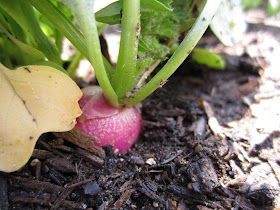As I sit here with a swollen leg, bruised from the knee to the ankle, I have to warn you that gardening can be downright dangerous. Here are just a few of the dangers in most gardens:
Stones - The reason I'm hobbling around. I was moving concrete blocks in a wheeled carrier, when one of the wheels got stuck in a hole and the carrier came down on my leg. Luckily, I was only bruised.
Spiders - In addition to my bruises, I also have two spider bites. (It just hasn't been my week.) Worried, I looked up the two most notorious spiders in my garden, the black widow and the brown recluse. Luckily, it must have been a different spider that bit my arm (twice).
Sunburn - Wearing sunscreen and hats help. If you get sunburned, there are a lot of home remedies you can use. I like aloe vera gel the best. Yes, I have sunburn this week, too!!!
Snakes - Always a threat to the gardener, snakes come out of hibernation about the same time we do! I have seen several baby snakes this week. I haven't run into the mom yet! I hope I don't!
Sticks (Plants) - Before picking a flower, my granddaughter asks, "Will this one bite?". She has learned that roses have thorns. With the rise in MRSA, antibiotic ointment is popular in my household. And it's not just scratches you have to worry about. There are a lot of weeds (and some beautiful plants) that are poisonous or caustic. Knowledge is important!
Scorpions - A threat here in the South, thankfully I've never been stung by a scorpion.
Sniffles - Allergies can wreak havoc on the budding gardener. Many people take medication. Thankfully, I don't have allergies!
Stings - Would you know what to do if you (or a visitor) got stung? Remedies range from applying meat tenderizer to using an EpiPen. Watching for life threatening symptoms is a must with every sting.
Saws and other electric/battery powered tools: I love my little chain saw, and my electric hedge trimmers. However, I know that severe bodily damage may occur in an instant from these machines. I try to remember to always, always hold the tools with both hands, and watch where I'm swinging them!
Other 'Stuff' -
Sore muscles.
Garden ponds. (Can be deadly - watch the children!)
Statuary. Mine once was in jeopardy of toppling over on me after leaning from a heavy rain.
Darkness. I'm not afraid of the dark, but I like to see where I'm going! Outside lighting helps.
Ladders. (Falling is dangerous.)
And a lot more, including lung diseases. (Feel like renting a haz-mat suit?)
I have noticed that I get hurt less when I concentrate on what I'm doing at the time. Which is hard for me. I have a tendency to daydream. I need to remember to concentrate more on the task at hand.
In this gardening blog about joy, why would I mention these jeopardies? Because a joyful gardener is a gardener that gardens without injury. (Try saying that three times fast!)
Have you ever been injured while gardening?


















































